News
Taking timber to greater heights
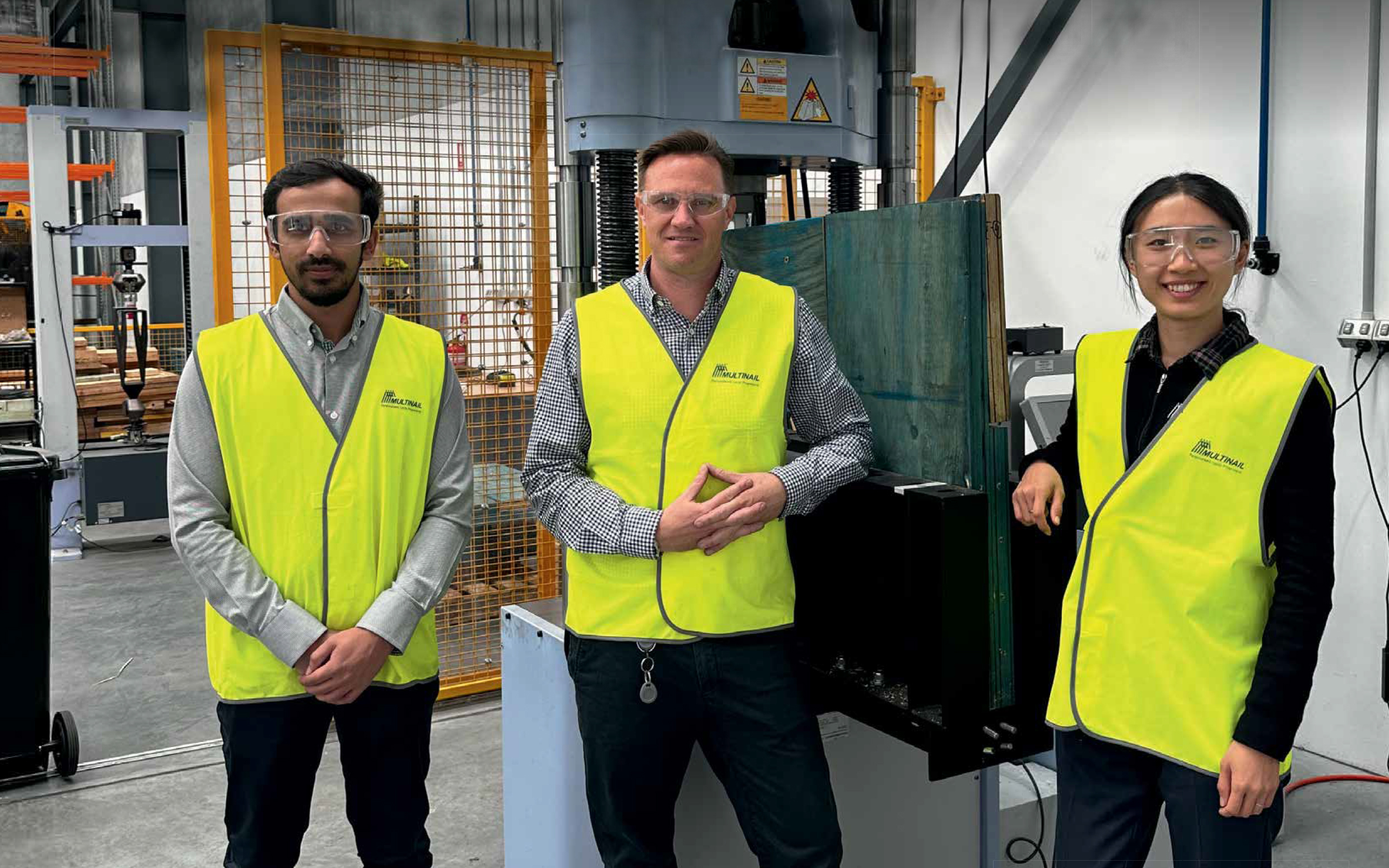
Multinail Advance: taking timber to greater heights
Multinail has announced their newest product, Multinail Advance offering a complete build solution which will see timber scaling new heights. By Nicky Ainley
As the building industry continues to see an increase in the use of timber in construction, Multinail Australia is focusing on bringing new products and services to a wider range of building types than the detached and semi-detached markets.
Multinail is proud to announce the launch of Multinail Advance, a new, exciting addition to the Multinail Brand. The core focus of Multinail Advance is to introduce Multinail’s extensive range of existing products and services to new markets while innovating and developing new solutions tailored to both the existing and new markets for Multinail Fabricators.
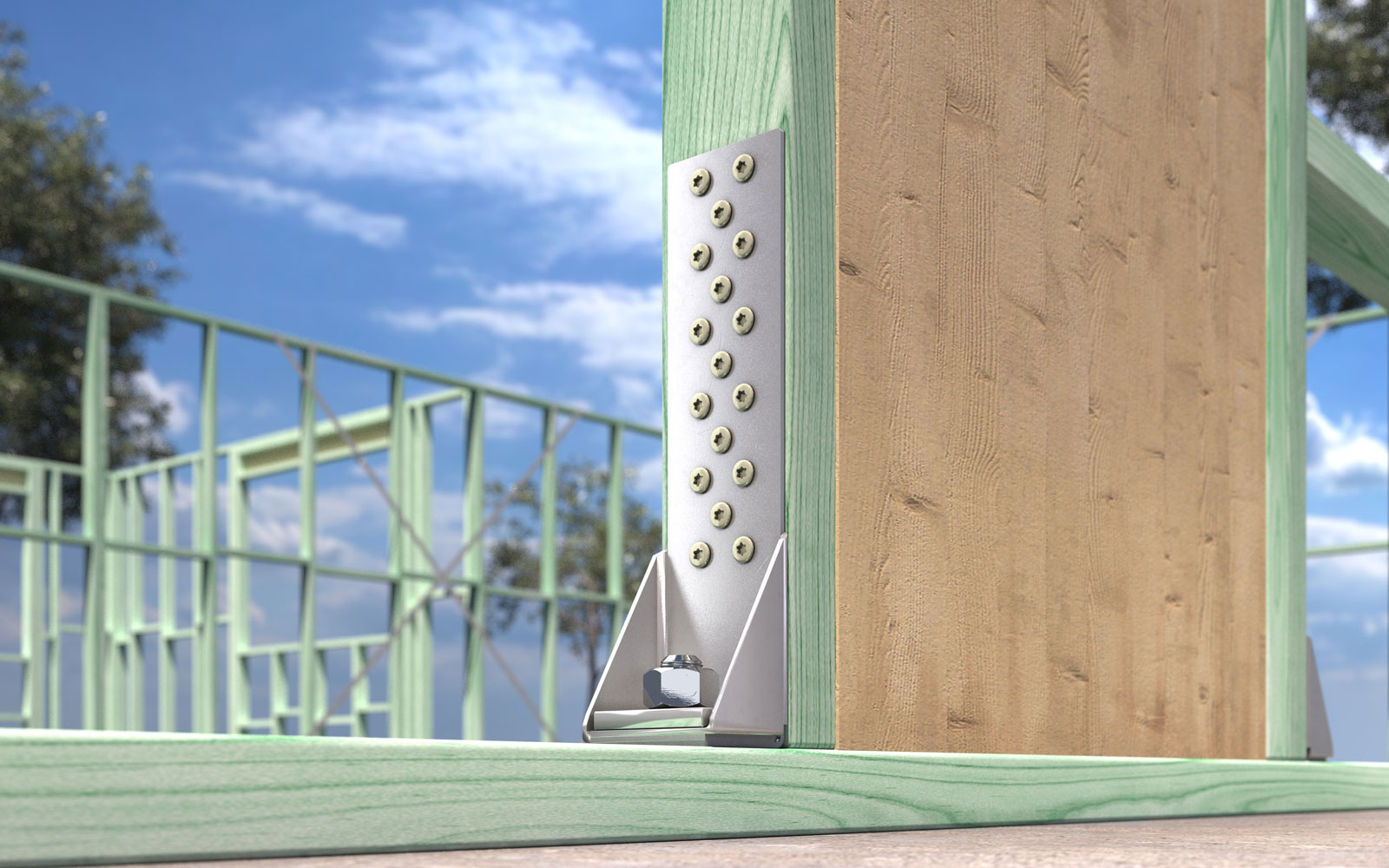
Short wall bracing using a Stronghold tie-down bracket can provide bracing requirements, ranging from noncyclonic to cyclonic regions.
MULTINAIL ADVANCE
Multinail Advance was developed to expand the company’s existing products, technology, and services into new building classes, keeping up with the NCC changes over the last few years and expanding the use of timber in construction. As mass timber buildings continue to generate attention in the Australian market, Multinail Advance is focused on bringing more timber construction options for Multinail Fabricators to the residential, multi-storey, and mass timber construction market.
For Multinail Fabricators, the market has primarily been in the detached, semidetached, and townhouse market. However, Multinail Advance is about taking the use of timber to higher multi-storey construction and incorporating a new range of products for larger timber members.
“The broader building industry still thinks that lightweight timbers can only be used in detached and semi-detached buildings; however, we can go a lot higher,” Travis Taylor, Chief Operating Officer, said.
“We are comfortable using small section timber in buildings up to 5-6 storeys high.”
“Multinail Advance is developing new products along with new services and systems to enable our fabricator base to move more confidently in these areas and to promote their products and services in this market space.”
DEVELOPMENT
While using timber in multi-storey residential builds is a more novel concept for Australian builders, it is not a new concept, with both the US and European markets already freely moving in this space.
“The Americans have been doing this for forty years, so it is nothing new to them, but it is new to Australians,” Taylor said.
“It is starting to grow in Australia. Currently, we have several fabricators nationwide in each state who are excited about the development and ‘can’t wait to go higher’.
“The challenge is getting the building community comfortable with the changes and encouraging architects and builders to steer away from the traditional large section steel and concrete building. Getting them to swap for a different building material is where the hesitation can be, and that’s the challenge for us, as part of the timber industry, to overcome.
“It’s not like swapping from Apple to Samsung,” Taylor continued.
“It’s not just swapping a product for a product; it’s how the engineers and architects design the building, and following that, the builders in this market segment need to adjust to new trades and the increased speed of the project.
“For builders who are used to working with concrete and the established tempo of a concrete build, timber projects will be completed quicker, possibly with a smaller workforce and a faster follow-on trade process.
“I recognise it’s a big change, however, we have customers already doing four-story buildings and are actively looking for more projects,” Taylor said.
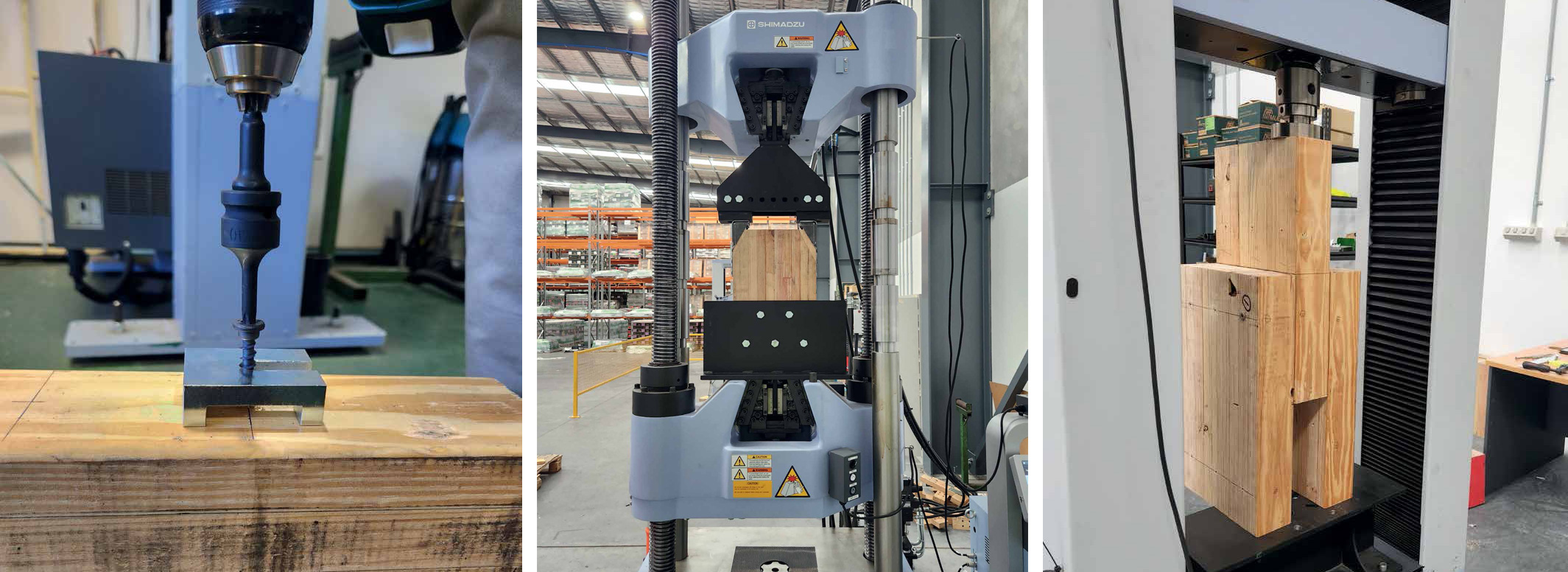
Left: Installation of Multinail advance pan head screws for testing.
Middle: Tensile test of Stronghold tiedown brackets with glulam.
Right: Screw joint shear testing with glulam.
PRODUCTS AND DEVELOPMENT
Multinail Advance has several products available now, with more to be released in the coming months as they move towards a timber-based solution for multi-storey and mass timber construction.
EcoBrace, their latest product, is a timber portal that will provide a timber solution that aims to reduce most of the structural steel used in residential buildings.
“Initially, this is aimed at detached, semidetached, and multi-residential buildings. Soon, we are going to start applying it to multi-level buildings,” Taylor said.
The portal system also expands into cathedral roofing, which can be obtained through customised design services. It can also be used in garages with roof and floor loads.
The second product is their Shortwall Bracing system, a steel bracing truss replacement. Currently, builders are using welded steel truss in short wall applications.
Multinail Advance now has a comparable product to this, using standard GLT.
“This enables Multinail truss plants to supply more products to the build at once and not wait on third-party suppliers. This is a pain point for many builders, as you must get your frames from one place and your steel bracing trusses from another. What if your steel bracing trusses don’t turn up on time?”
Additionally, Multinail Advance will release a new tie-down system for high-wind applications. This system will be used to tie down wall frame top plates to hanging beams and then to the slab. It removes the pain point of drilling through GLT or LVL hanging beams. It is expected to be available mid-year.
As for further steps, he says the next major development will be about light-weight timber bracing in multi-storey buildings and a mass timber connection range.
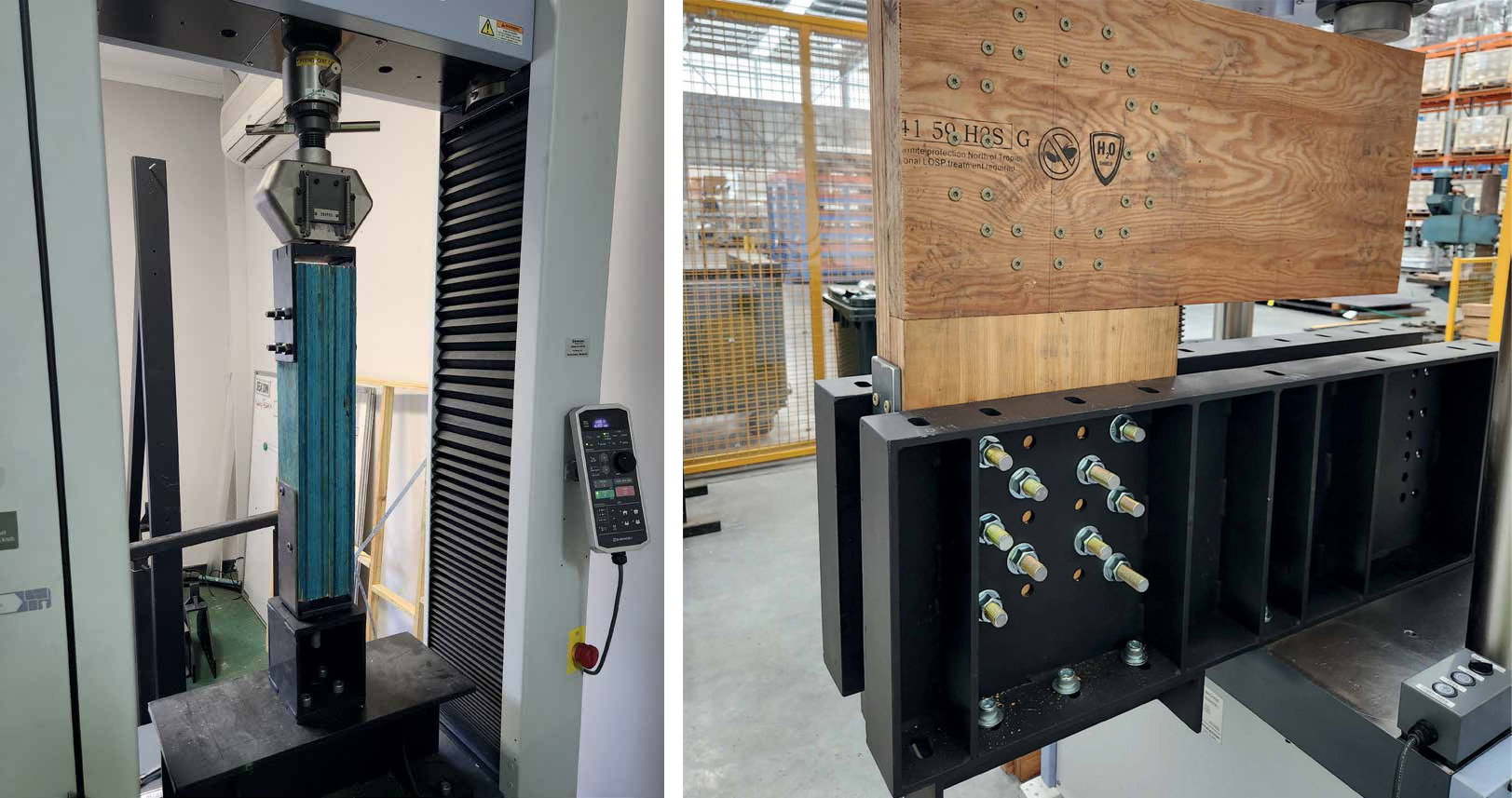
Left: Moment test of EcoBrace knee joint with LVL.
Right: Tensile test of EcoBrace column tie-down bracket.
BUILDING THE FUTURE
Multinail Advance will find an increased place in the growing building market, particularly with the government’s ambitious proposal to build 1.2 million houses.
“They are not going to do it in concrete; I don’t think you are going to do it all in modular construction or panelised systems either, as the numbers required for the targets the government has set are ambitious,” Taylor said.
“What I would like to see is the existing truss and frame network (of which there are
some 300) who are already geared up in terms of equipment, technical staff, and construction knowledge, to start looking at different building types, the capability of the Frame and Truss sector for far too long has been generally overlooked by architects, engineers developers and builders when it comes to buildings outside of the detached, semi-detached and multi-residential sectors.”
“Multinail Advance is working hard on bracing systems and tie-down systems, which we will release in the coming months to support this expansion.”
The two products cited above will be available as of May via Multinail’s extensive nationwide network of Fabricators.
“Detached and semi-detached housing is at its zenith. The Australian truss and frame industry is a well-oiled machine that manages quotes to detailing, manufacturing, and delivery. With what the rest of the Multinail group of companies will be releasing in the coming months and years, it will be even more efficient. The next major opportunity for the truss and frame sector is for townhouse, unit development either lowrise through to mid-rise construction and in hybrid buildings a combination of light weight and mass timber construction, where Multinail Advance has been focusing on for the last few years.” Taylor continued.
With supply chains heavily impacted in the past few years, Multinail recognises the need for a more streamlined process for builders to ensure that builds don’t become stagnant and build timelines blow out.
“We are trying to put more control back into the hands of truss manufacturers. They are a lot more capable than what the broader industry perceives, and it is about giving them more tools and systems to provide more confidence to builders in new markets who are thinking about swapping to timber.”
Taylor notes that while Australia has seen an increase in timber used in larger buildings, it is primarily supplied by the mass timber industry. Despite Australia being relatively new to mass timber buildings, we already have an excellent industry of 4 suppliers.
“We are doing some fantastic work, Collingwood VIC, Bendigo Gov hub VIC, Monterey Building Kangaroo Point QLD, just to name a few buildings supplied by the local mass timber industry in the last few years alone. This goes a long way to increasing the confidence of the construction industry and the population in using timber in more construction types.
As much as these buildings are fantastic, they won’t be the lion’s share of the construction market as Australia aims to solve its housing problems. Under the DTS provisions in the NCC, timber won’t be exposed, budgets for construction won’t be as high, and the more efficient use of timber will be required. In some circumstances, mass timber will be required. In others, lightweight timbers will be the better option, ensuring mass timber is used where it is best combined with lightweight timbers that provide the most efficient use of timber,” he said.
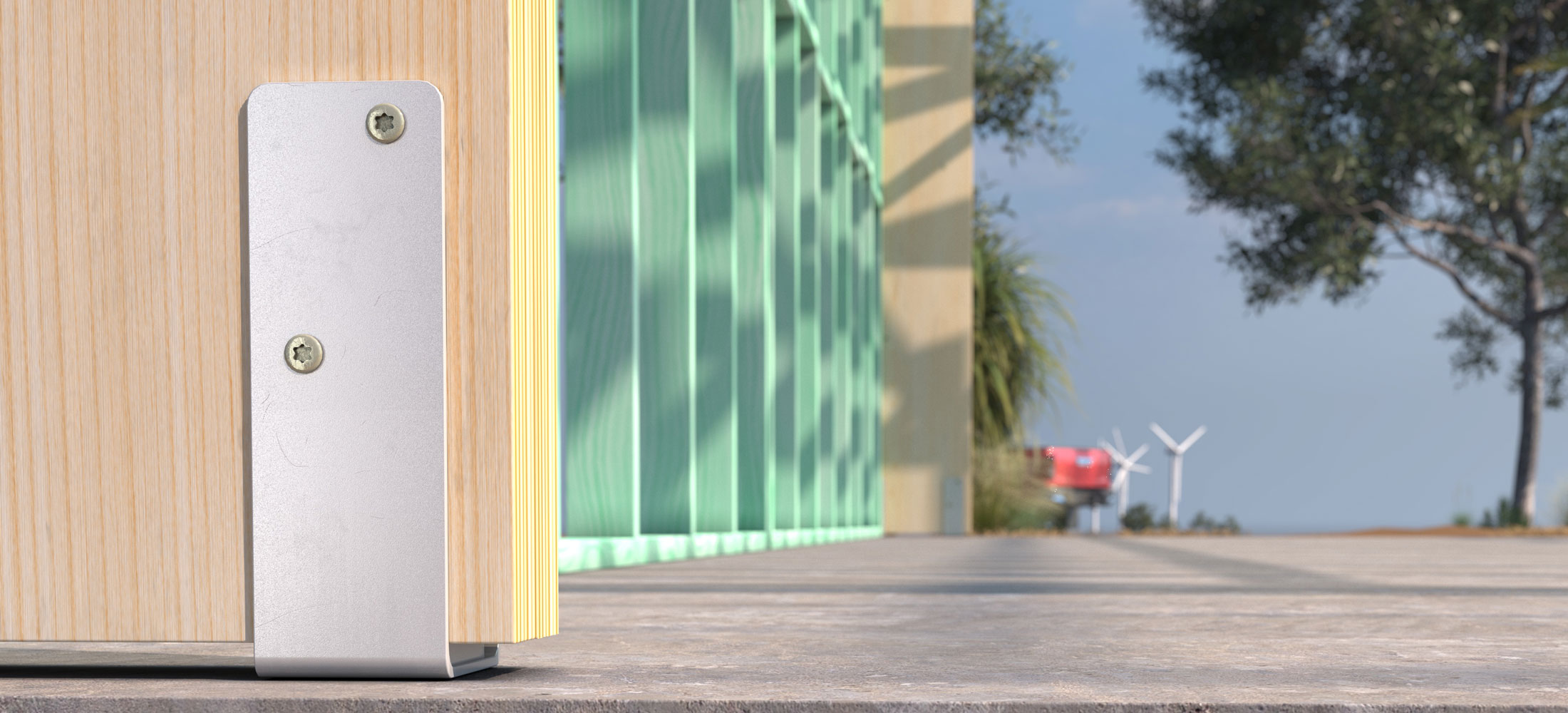
Ecobrace is a simple and effective site-built portal for achieving loading bearing and/or wall bracing requirements in residential construction with superior capability for withstanding lateral loads.
THE TIMBER PATH FORWARD
Taylor believes that using timber is potentially one of the only ways the government could begin to achieve its proposed housing target and environmental goals at the same time.
He believes that comparing Australia to the US and European markets is not beneficial as they are climatically and architecturally different. Europe has a restricted building window because of the weather and requires lockup quicker than we do in Australia. The American housing market is massive, much of which is based on repeatable buildings, whereas Australia’s building volumes are substantially smaller and infinitely more varied.
It’s a bright future for the dynamic familyowned business, with roots firmly anchored in the Australian timber construction industry and a heritage that extends over forty-seven years. During that time, the company has built an enviable culture of enthusiastic, committed staff vested in the success of Multinail fabricators throughout Australia. Their locally based teams are made up of highly skilled, passionate people with extensive experience and knowledge of the timber prefabrication industry.
Multinail is an Australian success story with a visionary focus on being the only company to provide the timber prefabrication industry with a fully integrated solution of Australian-made and supported structural building products, machinery, and software.
The superior quality of Multinail building products, machinery, and software doesn’t just happen overnight. It takes highly skilled, dedicated people working towards a common goal of ensuring everything they supply is produced to the highest possible standards of quality and performance.
The wealth of industry experience within Multinail ensures fabricators get the best from their partnerships. Whether advising on business development, productivity, upskilling staff or providing engineering support, a highly skilled, locally based team is ready to provide whatever service is required.
“The family culture at Multinail means we are adaptive and free of corporate constraints, creating a stimulating environment where innovation is alive in every division of the company. We encourage people to constantly seek solutions and advancements for the benefit of our fabricators.” Taylor summarised.
Multinail Advance is committed to enhancing the competitive edge of our fabricators by expanding timber construction into new markets and contributing to the growth of the Australian timber industry.
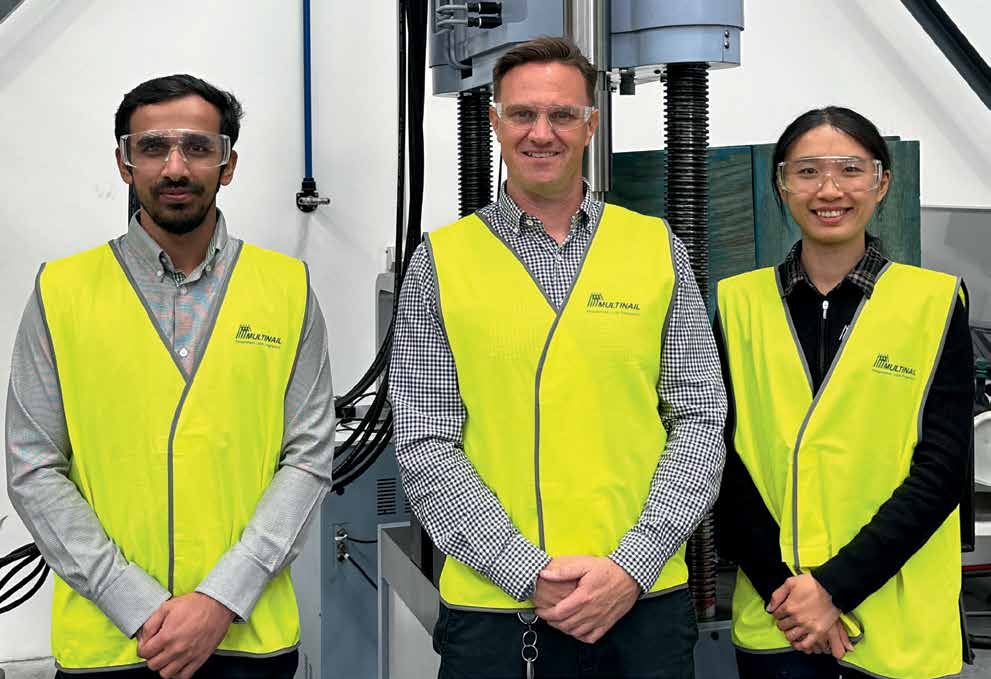
The Multinail Advance Team. Taking timber construction to new heights, Muhammad Iftikhar –
Graduate Structural Engineer, Travis Taylor – CEO Multinail Advance, Chelsea Cheng – Structural Engineer.
For more information visit:
www.multinail.com.au/multinail-advance
Source: Timber Trader News
Let’s Work Together